26. TIMBER JOINERY IN BUSHFIRE ZONES
BUSHFIRE CODES DON'T AFFECT URBAN AREAS DO THEY?
Yes. You can be subject to restraints if you live anywhere near a moderately forested area including parks or reserves in city areas. You certainly can be affected if you build in a suburban area that borders bushland or national park. Rural areas are obviously the focus of the code but it effects the outerlying areas of all urban centres, and pockets of bush even in city precincts.
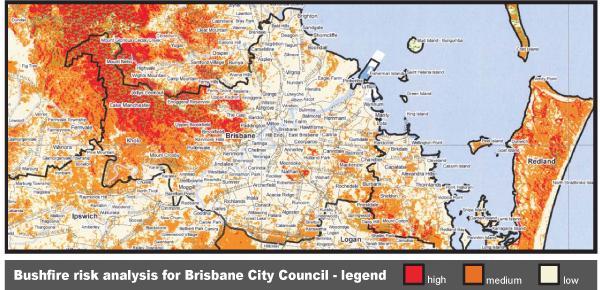
WHAT IS THE BUSHFIRE CODE AND HOW DOES IT AFFECT ME?
AS 3959-2009 "Construction of buildings in bushfire prone areas" aims to increase protection for people and buildings in bushfire areas. The standard is now referenced in the Building Code of Australia (BCA). The standard has six levels of risk listed in the chart below called Bushfire Attack Levels (BAL) with increasing requirements ranging from ember attack at low levels to open flames at the highest levels. The Code only applies to new construction and not existing buildings unless renovations or extensions are undertaken. In such circumstances you may be required to upgrade the existing structures to the new standards.
| Bushfire Attack Level (BAL) | Description of predicted bushfire attack and levels of exposure |
| BAL - LOW | There is insufficient risk to warrant specific construction requirements |
| BAL - 12.5 | Ember attack |
| BAL - 19 | Increasing levels of ember attack and burning debris ignited by windborne embers together with increasing heat flux between 12.5 and 19 kW m² |
| BAL - 29 | Increasing levels of ember attack and burning debris ignited by windborne embers together with increasing heat flux between 19 and 29 kW m² |
| BAL - 40 | Increasing levels of ember attack and burning debris ignited by windborne embers together with increasing heat flux with the increased likelihood of exposure to flames |
| BAL - FZ | Direct exposure to flames from fire front in addition to heat flux and ember attack |
In theory, anybody can determine their own BAL level using the guide set out in the Code but unless the certifier accepts your findings, you'll end up with the BAL the certifier (or one of his chosen colleagues) determines. The BAL is ascertained by following a template laid out over 20 pages of the standard, and determines to a large extent the design details of permissible doors and windows.
I WANT TO BUILD IN A BUSHFIRE AREA. CAN I USE TIMBER JOINERY?
Yes except at high BALs where restrictions apply. Everyone appreciates the aesthetics of timber, particularly in a bushland setting. The traditional Australian rural house in timber and tin is a beloved part of the rural landscape. Bushfire protection is about creating a fire resistant building envelope that does not permit burning embers and radiant heat to penetrate the dwelling and ignite spot fires. The Building Code of Australia (BCA) sets standards for structural adequacy, integrity and insulation for all elements of a new building according to its Bushfire Attack Level. These standards, of course, include the openings in the building envelope fitted with doors and windows. The standards permit the use of standard timber joinery throughout a new structure provided it is protected by compliant bushfire shutters which close over all openings to create a tightly fitted shield. Bushfire shutters are acceptable protection even at the highest level of bushfire attack (BAL FZ Fire Zone) but there are also a range of less expensive options for protection against lower levels of bushfire vulnerability. Most commonly these entail the use of fire resistant or retardant treated timber, draught seals and will also entail the installation of compliant metal mesh insect screens using aluminium, bronze or stainless steel weave with apertures of not greater than 2mm. These restrictions also have design implications on how joinery is positioned and installed. Your certifier makes the ultimate decisions in compliance with the standard, so choose wisely and consult early.
WOULD ALUMINIUM OR PVC JOINERY BE A BETTER CHOICE?
The exact same restrictions apply to all windows and doors regardless of the material used for their manufacture for all BAL's up to 29. Beyond BAL 29, timber and PVC are prohibited unless fitted with bushfire shutters. Although there are curbs on the use of some low density timbers in their natural state, virtually any timber can be used if it is fire retardant treated. The advantage of timber is that it insulates better than other materials thereby reducing radiant heat intrusion.
WHAT DESIGN IMPLICATIONS ARE THERE FOR DOORS AND WINDOWS?
The standards have implications in every element of the building envelope & a good overview is provided by the Wood Products Victoria Guide "Timber Housing in Bushfire prone areas".
The crucial aspects affecting door and window selection are position, materials and installation
Position
If your BAL level is deemed to be low there are no special requirements and standard door and window products can be used. If your BAL level is 12.5, 19 or 29 there are restrictions on positioning openings in the 400mm high zone above the surrounding floor or structure. This is defined as glazing or joinery that is within 400mm of ground or other structures within 18º of horizontal as shown in the diagrams below. The rationale is that embers build up against the base of walls and create a dangerous ignition point if the walls are perforated with windows and doors that are not designed for this danger. This usually means that windows need to be positioned above the floor and doors require specified thicknesses of timber in their lower portions, special glasses and protective screening or shutters. For the home owner this means that full height windows are now problematical and a low sill height at 400mm will allow views to be captured without inflating costs. Compliant insect screens are now essential in most situations together with draught seals under doors.
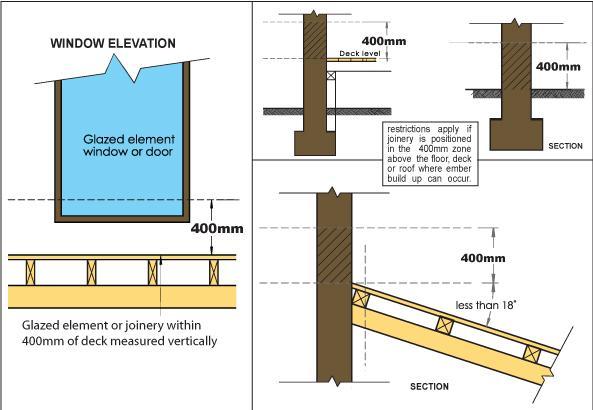
Materials
The standard lists a variety of acceptable timbers for bushfire zones that relates to their density, because as timber burns it forms a protective layer of charcoal that effectively insulates timber beneath from the heat. The denser the timber, the slower it burns and the starting point is 650 kg/m³ which encompasses timbers like New Guinea Rosewood, Blackbutt and even Slash Pine. There is a second level of bushfire resisting timber of species with a density above 750 kg/m³ which are acceptable untreated in BAL zone 40. The alternative is to treat timber with fire retardant chemicals to achieve comparable levels of fire resistance. This method allows the use of Surian Cedar and maple for joinery in BAL zones up to 29.
Installation
The standard prescribes clearances and tolerances for all elements of doors and windows to limit smoke or ember intrusion. Generally no clearance can be greater than 3mm around any element. All bushfire shutters must be non-removable but must be openable/operable from either inside or out but at least one must be openable/operable from inside to allow egress from the building.
WHAT TIMBERS COMPLY WITH THE CODE?
The Code has two lists of timber species that are deemed to be fire resistant. Other species can be elevated to fire resistant level by the application of fire retardant chemicals to the raw timber.
List 1: Species with a density of 650 kg / m³ or greater. More than 60 species are listed based on crude weight, although many other heavy species would also comply. Over 60% of the list are Eucalypts but many are unsuitable for joinery. The list includes the Eucalypts, Blackbutt, Ironbark, Jarrah, as well as Kwila, Merbau, American Oak, New Guinea Rosewood and Vitex.
List 2: There are only a handful of species with density greater than 750kg/m³ that have been tested to withstand exposure to BAL 29 and are deemed to be bushfire resistant. These include, Blackbutt, Ironbark, Spotted Gum and Red River Gum as well as Kwila, Merbau and Turpentine. Most of these species are not used generally for joinery because of other inherent supply or performance problems. However Kwila and Merbau are acceptable joinery timbers.
HOW EFFECTIVE IS FIRE RETARDANT TREATED TIMBER?
Fire retardant systems for treating timber use a process called 'intumescent protection'. The raw timber is fully coated with the chemical on all exposed faces which does not react with subsequent paint finishes. Timber fire retardants are non toxic and do not produce toxic gas when ignited. They are totally safe to use and have no impact on plants or animals. They are invisible when applied and improve the dimensional stability of the timber. The technology behind retardants is based on selective modifications of cell groups within the timber. The process has been known and researched for over 80 years. The physical properties that make any material are determined by its chemical structure. Timber is predominantly formed by chemical groups called "free hydroxyls". These free hydroxyl groups absorb and release water in accordance with changes in the relative humidity and other climatic conditions. By selectively altering the free hydroxyl groups, the timber is transformed into an entirely different material. Its appearance remains the same but its performance is greatly altered for the better. Retardant transformed timber has remarkable fire resistance as well as the added benefit of dimensional stability. This does not mean that the timber will not ignite but when the heat source is removed, no fire or afterglow will remain.
WHAT GLASS RESTRICTIONS APPLY?
The bushfire code virtually bans the use of laminated glass in all but the lowest level BAL's. Depending on the attack level, toughened glass is required in increasing thickness according to danger level. Toughened glass is simply glass that has been reheated and cooled quickly so that it's structure changes to make it more flexible and softer. Toughened glass cannot be cut after it is treated and it is easier to scratch, so particular care needs to be taken with cleaning on site.
WHAT JOINERY CAN I USE?
You have the option in every BAL zone to avoid most of the detailed requirements for timber joinery by either
| A | Fitting all external glazed elements, assemblies and external doors with compliant bushfire shutters. These shutters must form an effective shield to fire and therefore need to be solid fire resisting barriers that fully protect the joinery over which they are tightly fitted. |
| or | |
| B | Fitting compliant metal mesh screens over all external glazed elements, assemblies and external doors which are corrosion resistant steel or bronze and fully enclosed the openings including joinery frames back to the building element to which they are fitted. This means every opening, including fixed glass, needs to be fully wrapped in a custom fitted metal cage that leaves no part of the joinery or its frame exposed. |
Should you be in a BAL 40 or FZ area, the two options above are compulsory. If you are in a less fire prone area then you have a range of options (see tables below) that are slightly less stringent, or you can choose fire shutters or screens to achieve a higher level protection than required by the standard.
LEGEND
FR - Fire resisting timber from List 1 or 2 or fire retardant treated timber;
FR 2 - Fire resisting timber from List B only or fire retardant treated timber
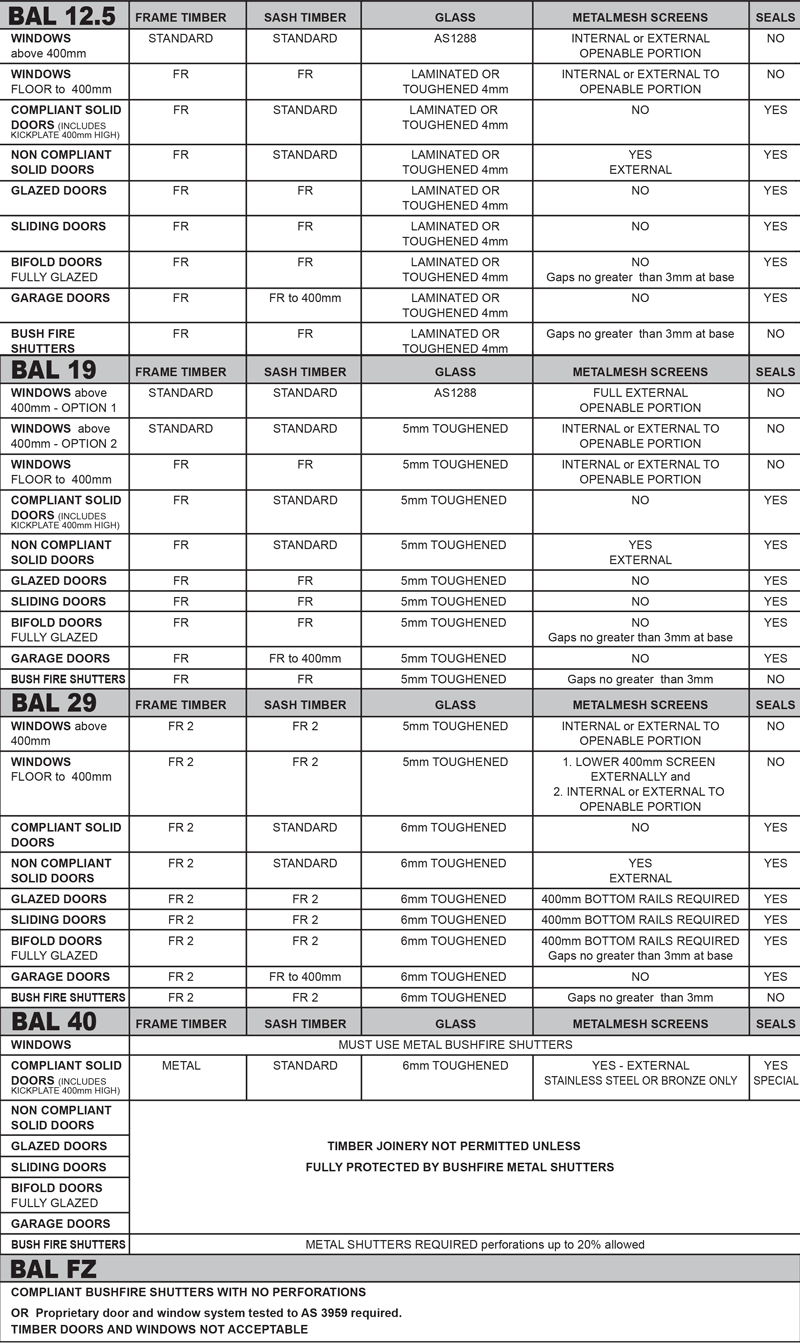
WHAT WOODWORKERS STOCK DOORS COMPLY FOR EXTERNAL USE?
Woodworkers has a selection of entry doors and pivot designs that comply with the code, all of which are either solid timber designs or fusion solid core flush patterns.
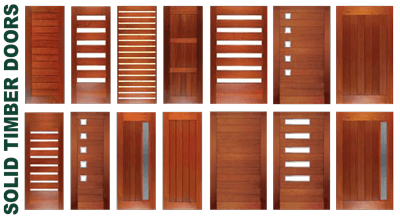
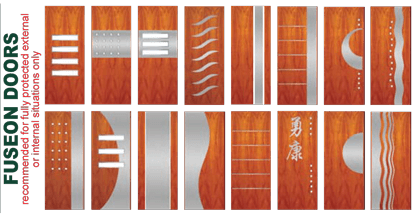
Traditional designs with panels or ply in the lower 400mm of the door would not comply unless a potentially unsightly metal or toughened glass 400mm high kickplate was installed at the base. Where a traditional design is preferred, it may need to be custom manufactured to achieve compliance. Shop drawings would be necessary to verify if the adaption required would be aesthetically acceptable. Examples of design adaption required are shown below.
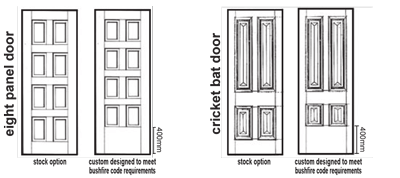
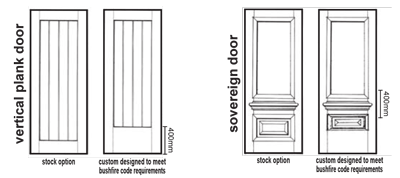
WHO IS RESPONSIBLE FOR MAKING SURE MY BUILDING COMPLIES?
Your builder - usually in consultation with the certifier, as the certifier makes the final decision. If a building has not been designed and built with the bushfire code in mind, it is likely to prove very expensive and awkward to retrofit compliant shutters to achieve certification.
HOW DOES WOODWORKERS JOINERY MEET THE CODES?
Woodworkers can manufacture joinery in N. G. Rosewood or other compliant species for BALs up to 29, or retardant coat its stock Surian red cedar joinery to achieve this same level. Retardant treated Woodworkers Crimscreen doors (with apertures between the mesh of 1.5mm) can be used externally on untreated joinery up to BAL 19 and above that level to BAL 29 with treated Surian joinery. Woodworkers bushfire shutter options can be used with standard Surian joinery (untreated) up to BAL 29. The standard stock joinery options offered by Woodworkers are only suitable for low level BAL's to 19 when used with compliant screens, or can be used to any level including FZ if protected by bushfire shutters. Retardant treatment is required above BAL 19 to BAL 29 unless compliant shutters are used. Woodworkers joinery is not suitable for BAL zones 40 and FZ unless fully protected by bushfire shutters. For detailed solutions to the challenges posed by the bushfire code as they relate to your building, we recommend that you discuss your requirements with sales staff but liaison with your certifier will also be necessary as they make the final decision in interpreting the code.
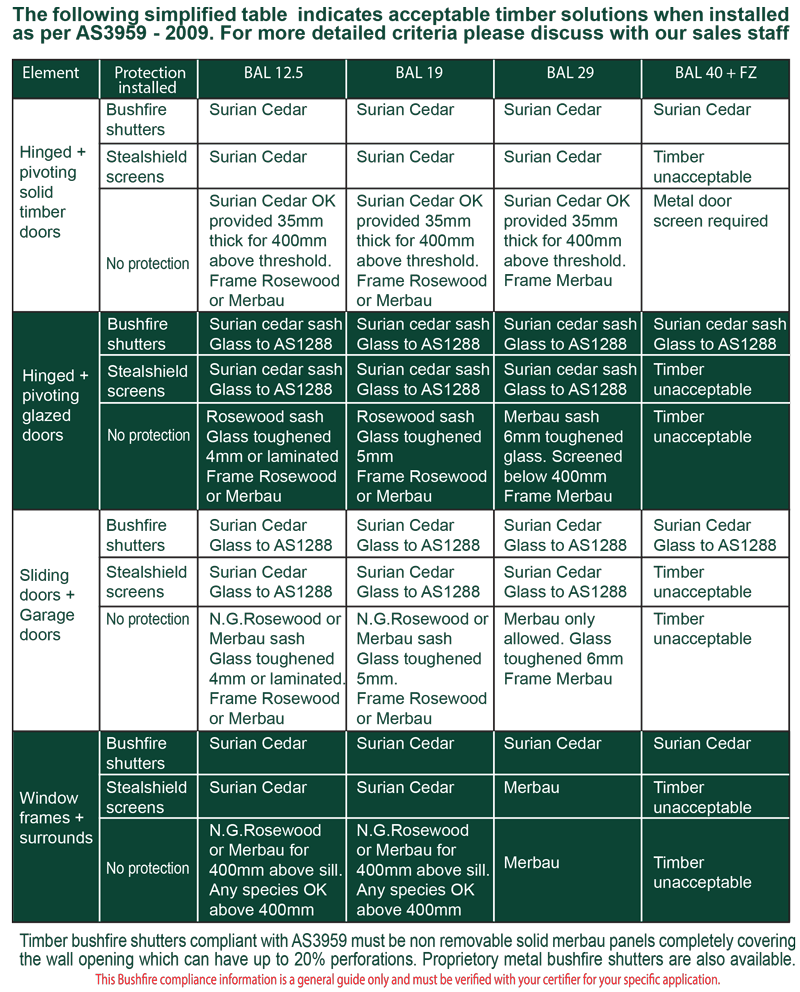
WHAT IS A COMPLIANT BUSHFIRE SHUTTER?
Bushfire shutters basically need to be a total block out exterior shield that closes over the doors, windows and their frame, tight fitting to the building element to which they are fitted for protection against embers and radiant heat. They can be vertical metal roller doors or side hinged metal, glass, composite or solid wood shutters. The Code gives the option of either using shutters to shield all external joinery or building the external joinery to the same protection level as that provided by the shutters. All shutters need to be constructed to comply with AS1530 for the BAL in which they are used, which means,
BAL 12.5 and 19
Timber must be 35mm thick and fire resistant from List A or B (see below) or fire retardant treated. Glass must be 5mm toughened.
BAL 29
Timber must be 35mm thick fire resistant species from list B (see below) or fire retardant treated. Glass must be 6mm toughened.
BAL 40 and FZ
Proprietary non combustible metal shutters required.
All shutters need to be non-removable and hung on metal hardware with no more than 3mm clearance between the shutter and the surrounding wall, sill or head so that they protect the entire window or door assembly. They need to be readily manually operable from either inside or outside, but where fitted to external doors at least one shutter must be operable from inside to allow safe egress. They can have up to 20% of their face perforated up to BAL 40 provided the apertures of the mesh are not larger than 2mm for ember protection.
 My Account
My Account My Wishlist
My Wishlist My Enquiries
My Enquiries